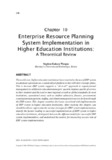| dc.description.abstract | The world over, higher education institutions have resorted to the use of ERP system to automate operations on a standardized platform in line with their strategic plans. This is because ERP system supports a “do-it-all” approach to organizational management in addition to education managers’ quest to improve quality of service to their students and the need to meet regional as well as global standards. In most institutions, operational areas such as student admission, finance, procurement, examination management, staffing, and alumni management can now be done through the ERP system. This chapter examines the issues associated with implementation of ERP system in higher education institutions. After studying this chapter, you should be able to: appreciate the various strategies for ERP system implementation, identify the factors leading to successful implementation of ERP system in higher education institutions, distinguish between the different models for successful ERP system implementation, and understand the metrics for measuring success rate of ERP system implementation | en_US |

